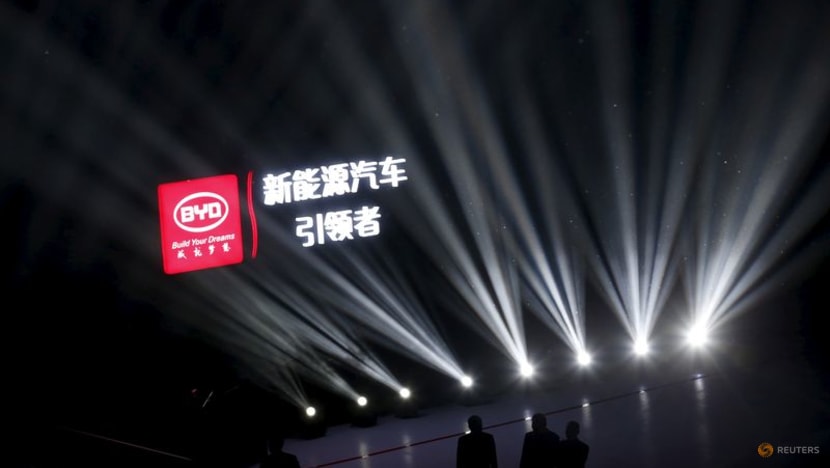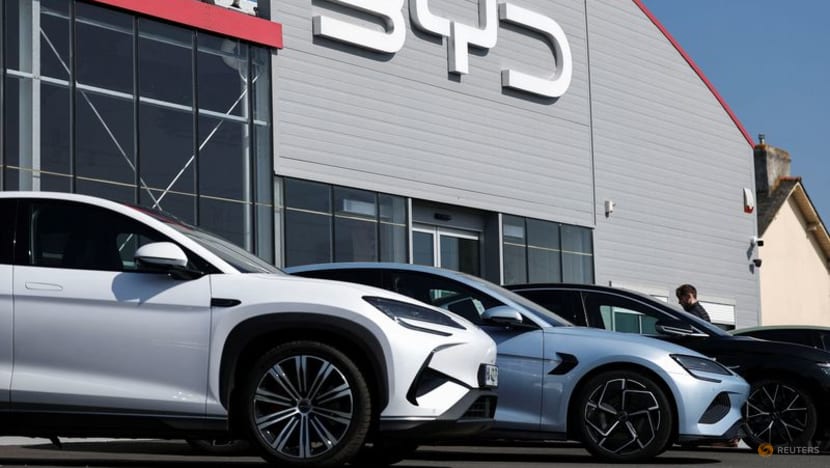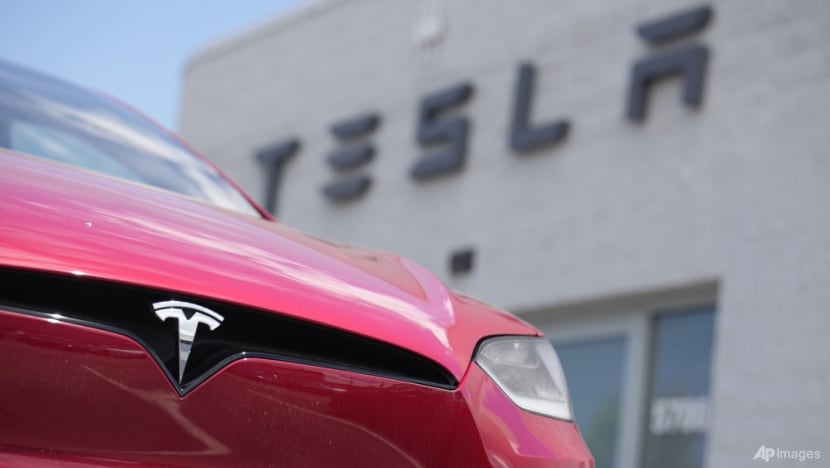BYD cars grow in popularity as Singapore consumers shed perception of 'made-in-China' as second-best
SINGAPORE: Chinese electric vehicle (EV) maker BYD has overtaken Toyota as the top-selling car in Singapore — and it’s due to a combination of attractive pricing and increasingly positive brand sentiments towards Chinese technology, said drivers and analysts alike.
Data by the Land Transport Authority (LTA) showed that BYD sold 3,002 cars, or 20 per cent of total vehicle sales in Singapore in the first four months this year.
It dethroned Toyota as the most popular car - the Japanese manufacturer sold 2,050 cars in the same period - and far outsold its main EV competitor Tesla, which sold 535 cars.
In 2024, Toyota sold 7,876 cars here, more than BYD’s 6,191.
But it was only in 2020 that BYD sold just three cars in Singapore, according to LTA data. This figure rose to 89 in 2021, 786 in 2022 and 1,416 in 2023.
In contrast, Toyota sales have remained relatively stable - with 7,704 in 2020, 9,633 in 2021, 6,405 in 2022 and 7,248 in 2023.
Tesla’s sales have also increased over the years, but not as quickly as BYD cars. Elon Musk’s firm sold 20 cars in 2020, 924 in 2021, 875 in 2022, 941 in 2023 and 2,384 in 2024.

FOR THE MASS MARKET
The figures showing BYD’s meteoric rise do not surprise BYD owners and experts.
One major deciding factor for many BYD drivers was the price - which they said was relatively lower than internal combustion engines (ICE) cars and other EV brands.
Ms Ng Lay Peng, who purchased the BYD Atto 3 model early last year, never intended to purchase an EV, having only driven ICE cars previously. But the quality and price of the Chinese automobile swayed her.
She said that while ICE vehicles in the same price range looked “quite basic”, the BYD model exceeded her expectations.
“When you enter, it doesn’t feel like a cheap car, it has the bells and whistles … it just feels comfortable; the drive is comfortable,” said the 36-year-old, who works in public relations.
She said the Atto 3 had a large interior and also came with features such as a sunroof. These could also be installed on an ICE vehicle she was considering at the same time, but at additional cost.
All in all, the BYD car was about 20 per cent cheaper than the ICE model she was also mulling over.
Another BYD owner, who only wanted to be known as Mr Tan, said he bought the M6 model for about S$175,000 earlier this year.
In comparison, he said a typical ICE car of similar build would be slightly more expensive and would not come with the BYD’s features such as ventilated seats, a sunroof and tyre pressure monitor.
Professor Lawrence Loh said the economies of scale achieved by the Chinese manufacturer have contributed to its cheaper products.
“It’s already the top selling car in China and the top selling EV car in the world,” said Prof Loh, who is the Director of the Centre for Governance and Sustainability at the National University of Singapore (NUS) Business School.
Large factory complexes have been built to manufacture these vehicles at scale, and this helps to lower the cost of each vehicle, he added.
As such, the EV is made for the mass market, and is considered an “entry-level” product, said Associate Professor Raymond Ong from the Department of Civil and Environmental Engineering at NUS.
“If you compare the price of a typical entry-level BYD to Tesla … BYD is very competitive in pricing, and that has an impact on potential car buyers and hence a leap in its market share,” he said.
The Tesla comes with a different value proposition, said YouTube EV car reviewer Daren Yoong.
It emphasises a more “minimalist” concept that is a hit among tech enthusiasts, but caters to a different audience from the BYD.
“The BYD is a really good starting point for most people,” said Mr Yoong, who is also a sales coach in a US tech company.

STRONG BRANDING
The growing recognition of Chinese brands overall has also helped catapult BYD to its recent popularity. Long gone are the days where “made-in-China” is seen as second best.
But this brand equity was not built up overnight, said Mr Yoong.
“Your iPhones, your DJI drones, your MacBooks, they’re all made in China, and made in China is starting to be recognised as quality over time,” he said.
“BYD has done a good job in crossing a very tough hurdle of getting the brand not just recognition, but also trust,” he added.
BYD’s marketing strategy has also been a success, said Prof Loh, noting the proliferation of its showrooms and dealers in Singapore.
“They’re located right smack in the middle of the financial district, you go to Suntec City, there’s a dealer there,” he said. “Many of the distributors and dealers are near workplaces, some are in residential areas, you can see their strategy is (to make it) convenient to buy.”
“You don’t go to a BYD, BYD comes to you,” he added.
The brand has become noticeably prominent over the years. BYD electric public buses have also begun to ply Singapore roads.
Earlier this year, homegrown tech firm Grab announced plans to expand its EV fleet with up to 50,000 BYD vehicles across Southeast Asia.
“(BYD) is going to be everywhere, it's going to be a big, ubiquitous brand,” said Prof Loh.
“They’re not trying to be premium, but going by volume, going by presence, (they are) literally conquering the whole market.”
PRACTICAL CONSIDERATIONS
Despite its growing popularity, BYD still generates some second thoughts among buyers.
Ms Ng, the owner, said she worries about the resale value of her BYD.
“There’s an uncertainty compared to ICE cars,” she said.
There have been reports that EV buyers are likely to wait for new technology rather than buy used EVs, on top of the perception of battery degradation.
Mr Yoong said that compared to its main EV competitor Tesla, BYD may not fetch as good resale value at present.
“Tesla has a more established brand in the EV industry, while BYD is newer and has less historical vehicle transactions,” he said.
This means that Teslas would likely fetch proportionately higher values in the resale market.

Ultimately, however, the price and functionality of a BYD car took the front seat in Ms Ng’s decision to purchase one.
The infrastructure for EV ownership has also been improving over the years, as Singapore targets all new car and taxi registrations to be of cleaner-energy models from 2030.
“I think there was some concern about EV charging, but we got used to it pretty quickly,” she said. Her Housing Board estate has several chargers in its car park; failing that, there are also fast chargers at a nearby industrial area.
She is now part of a BYD Telegram chat specifically created for her car model and set up by another owner. When she joined it early last year, there were about 500 members, a number which has since grown to over 1,200.
“When we have questions about the vehicle or need to troubleshoot anything, someone will always reply,” she said.
免责声明:投资有风险,本文并非投资建议,以上内容不应被视为任何金融产品的购买或出售要约、建议或邀请,作者或其他用户的任何相关讨论、评论或帖子也不应被视为此类内容。本文仅供一般参考,不考虑您的个人投资目标、财务状况或需求。TTM对信息的准确性和完整性不承担任何责任或保证,投资者应自行研究并在投资前寻求专业建议。
热议股票
- 1
- 2
- 3
- 4
- 5
- 6
- 7
- 8
- 9
- 10